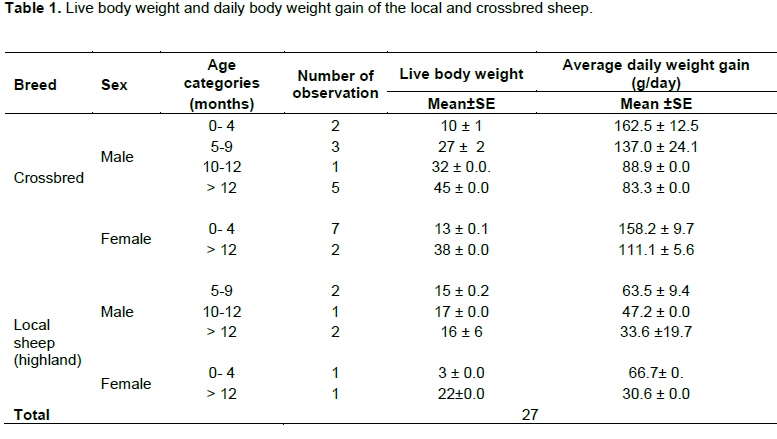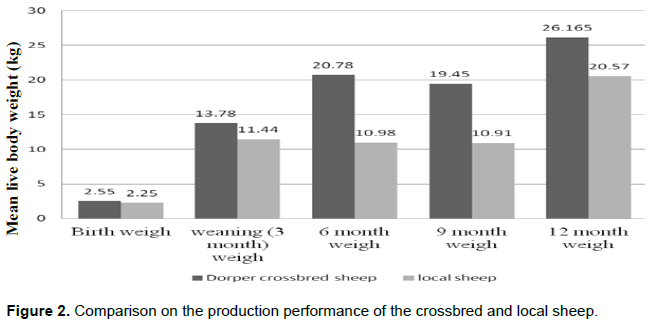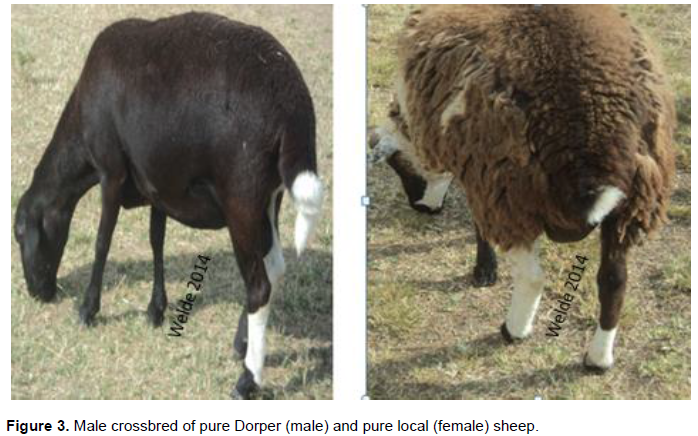ABSTRACT
The study was conducted in Hawzen and Hintalowagerat districts of Tigray region Northern Ethiopia with the objective of enhancing meat production performance of the local sheep through cross breeding with high yielding exotic Dorper sheep under smallholder farmers. Pure male Dorper mated with local sheep produced first and second generation with 50 and 25% blood level of Dorper, respectively. Farmer’s research groups were established in both locations. The average live body weight of the 50% crossbred male and female sheep was 45 and 38 kg, respectively at adult age. The average live body weight of the adult male and female local sheep (highland) was 25 and 20 kg, respectively. On farm crossbreeding of Dorper (male) sheep with local sheep (female) improved body weight by 55% (male) and 53% (female) at yearly age. Smallholder farmers perceived that Dorper crossbred sheep are appropriate for meat production improvement. It is concluded that regardless of the black body color and the appearance short thin tail of the crossbred, Doper sheep breed is the appropriate technology for enhancing meat production performance of the local sheep.
Key words: Crossbreeding, Dorper sheep, meat production, local sheep.
Sheep production dominates in almost all of the highland agroecology of Ethiopia. Indigenous sheep populations are adaptive to local environment and varied topographical features. It becomes an important economic activity under small hold farmer for household food security in all part of Ethiopia. Most of the indigenous sheep are reared under traditional production system for subsistence production as means of obtaining meat, manure and cash (Hassen et al., 2004). They are a source of risk mitigation during crop failures, of property security and of monetary saving and investment in addition to many of other socio-economic and cultural functions (Tibbo, 2006). The regional government of Tigray is endowed with huge number of 1.4 million sheep This number is proportionate in zones from highest to lowest as western, Southern, Central ,Eastern and Northwestern Zones of Tigray, respectively. The indigenous sheep have poor production performance under small holder farmer. Dorper is a superior meat type sheep breed in South Africa developed through the long time effort of crossbreeding of Black-headed Persian and the Dorset Horn in 1930 (Gavojdian et al., 2013). To improve the productivity of indigenous sheep, crossbreeding with high yielding exotic Dorper sheep breed is valuable for market oriented meat production and for enhancing the benefits obtained from the local sheep (Helen et al., 2015). The Ethiopian Sheep and goat productivity Improvement Program (ESGPIP), a USAID support project, was implemented in different parts of Ethiopia with the objective of improving the productivity of the local sheep of Ethiopia. The objective of this paper is therefore to present the performance crossbreeding of Dorper sheep with local sheep.
Objectives
1. To enhance meat production performance of the local sheep through cross breeding with Dorper exotic sheep breed
2. To upgrading local sheep breeds through cross breeding with high yielding exotic breeds
History of imported Dorper sheep
The pure breed of Dorper male sheep were introduced from Werer (Afar), Haremaye University and Fafan (Somali) found in Ethiopia. The introduced Doper sheep were used for crossbreeding with highland sheep under smallholder farmer. Collection of the genetic material from other sites of our country that have already introduced the breed was used as alternative option using and IRISH-Aid funded operational research for food security project.
Description of the study area
The regional government of Tigray is found Northern Ethiopia and is located between 36 and 40° East longitude. Its north-south extent spans 12.5 to 15° north. It is bordered by Eritrea in the north, Sudan to the west, Amhara to the southwest and Afar in the east. The study was conducted Eastern zone of the region (Hawzen and Hintalowajerat districts) under mixed crop livestock production system is the dominant agricultural production system in the highland agroecology of Ethiopia (Institute of Biodiversity Conservation, 2004). Agricultural is the backbone for household food security of the smallholder farmers in the study area. Wheat and Barley are the major crops grown widely under rain fed conditions. Maize is the cash crop grown at both rain fed and irrigation conditions. In both districts, sheep are among the livestock species kept by smallholder farmers.
Introduction of Dorper sheep and animal management
Three male Dorper sheep (two at D/chidan water shade housed in Farmers Training Center (FTC), one in Hintalo Wajerat Farmers Research Group (FRG) were introduced. These animals were managed under traditional management system of the local sheep and their adaptability was evaluated together with the participated farmers. The local female sheep were mated with pure male Dorper sheep and produced crossbred sheep.
Mating procedure
Ram services system was used during grazing hours. Pure Dorper (male) mated with pure local sheep (female) produced crossbred male and female lambs (Figure 1). The rams gave mating service to the local sheep of the Framers Research Group established around the Farmers Training Center in Gebrekidan and Amdeweyane water shads.
Data collection
Live body weight was collected at birth date, weaning date, and yearly for both crossbreds and local sheep using spring balance with accuracy to the nearest of 0.5 kg.
Data analysis
Descriptive statistic was used to calculate mean of live body weight at birth date, weaning and yearly age. Figures and Tables were used to present quantitative data.
Comparison on live body weight
The comparison of local and crossbred based on the live body weight is presented in Table 1. The average daily body weight gain for male crossbred at the age group of 0-4, 5-9, 10-12 and >12 months was 162.5 ± 12.5, 137.0 ± 24.1, 88.9 ± 0.0 and 83.3 ± 0.0 g, respectively. Whereas for the female crossbred, the average daily body weight gain at the age group of 0-4 months and >12 months was 158.2 ± 9.7 and 111.1 ± 5.6 gm. The average daily body weight gain for male local sheep at the age group of 5-9, 10-12 and >12 months was 63.5 ± 9.4, 47.2 ± 0.0 and 33.6 ±19.7, respectively. Whereas for the female local sheep, the average daily body weight gain at the age group of 0-4 and >12 months was 66.7± 0.0 and 30.6 ± 0.0 g, respectively. The current study observed that the average body weight gain was higher for Dorper crossbred sheep under traditional management system. The male crossbred sheep reached marketable weight (27 kg at 5-9 months) as compared to the male local sheep (15 kg at 5-9 months). Dorper lambs can grow daily by 206 g/day post weaning supplemented with concentrated feeds (Cloetea et al., 2000). According to Byrne et al. (ND) Doper lambs have live body weight gain of 240 to 280 g/day tested at varied environmental conditions. The early weaning age (2 to 3 months) of the Doper lambs have a potential of enhancing post-weaning gains 180 to 200 g/day (Byrne et al., ND).

Improvement on the meat production performance of the local sheep
Crossbreeding Dorper exotic sheep breed with the highland sheep improved the growth rate of the local sheep. The average live body weight for male and female crossbred sheep at adult age (>1.5 years) was 45 and 38 kg, respectively. The current study observed that crossbreeding with Dorper sheep improved the growth rate of the local sheep by 89 and 78% at 6 and 9 month age, respectively (Figure 2). This result of the current finding is in line to the previous of Lakew et al. (2014) who found that the crossbred ewes were found weighed more than the local sheep ewes at adult age (32.7 ± 0.63 vs. 22.8 ± 0.43 kg).
The body weight performances of the Dorper crossbred have got premium result in improving the local sheep worldwide (Lakew et al., 2014). The current suggested that Dorper sheep is an appropriate technology for producing crossbred lambs with better growth rates under smallholder farmers (Figure 3).
Smallholder farmer perception towards the Dorper crossbred sheep
Informal interview of the smallholder farmer indicated that the crossbred have non-selective feed behavior and excellent in meat production under farmer`s management. Farmers of the watershed are highly interested and demanding introduction of additional rams. Some of the beneficiaries have earned up to 2200 Birr form the sale of adult crossbreds.
Doper sheep breed is the appropriate technology for enhancing meat production performance of the local sheep under smallholder farmers. It has the potential to improve meat production performance of the local sheep by 53%. Introduction of male crossbred sheep of Dorper have better adaptability under smallholder farmers. Therefore, upgrading the local sheep through continuous back crossing with male crossbreds of the first generation has a potential to solve the problem of adaptability to the local environment. Strengthening the capacity of nucleus site sheep farm is necessary for sustainable dissemination of the improved crossbred meat breed to smallholder farmers. Introduction of improved feeding technology like Urea Molasses Block and Urea molasses treated straw are better to be provided as a package while the improved breed is disseminated to farmers.
The author has not declared any conflict of interests.
REFERENCES
|
Byrne TJ, Amer PR, Fennessy PF, Rohloff RM, Cromie A, Donnellan P, Potterto G, Hanrahan JP, Wickham B (ND). Progress in the development of breeding schemes for the irish sheep industry: the maternal lamb producer groups bacusbio limited, Irish cattle breeding federation society limited, high field house shinagh, Galway, Ireland. Proceedings of the Association for the Advancement of Animal Breeding and Genetics, Barossa, South Australia (2009):434-437
|
|
|
|
Cloetea SWP, Snyman MA, Herselman MJ (2000). Productive performance of Dorper sheep. Small Rum. Res. 36(2000):119-135. Elsevier Science B.V.
Crossref
|
|
|
|
|
CSA (2013). Agricultural Sample Survey 2012/2013(2003 E.C.) Volume II: Report on Livestock and livestock characteristics (Private peasant holdings). Statistical Bulletin 570. Central Statistical Agency (CSA), Federal Democratic Republic of Ethiopia, Addis Ababa April 2013.
|
|
|
|
|
Gavojdian D, Cziszter LT, Sauer M (2013). Productive and reproductive performance of Dorper and its crossbreds under a Romanian semi-intensive management system. South African Journal of Animal Science 2013, 43 (No. 2). Accessed on December 20 2014.
Crossref
|
|
|
|
|
Hassen Y, SolKner J, Fuerst-Walt B (2004). Body weight of Awassi and indigenous Ethiopian sheep and their crosses . Sheno Research Center, Debre Birhan, Ethiopia. Department of livestock science, University of Agricultural sciences Vienna Gregor Mendel –strass 33, A 1180 vienna, Austria.
Crossref
|
|
|
|
|
Helen N, Yoseph M, Solomon A, Kefelegn K, Sanjoy KP (2015). Indigenous Sheep Production System in Eastern Ethiopia: Implications for Genetic Improvement and Sustainable Use. Am. Sci. Res. J. Eng. Technol. Sci. 11(1):136-152.
|
|
|
|
|
Institute of Biodiversity Conservation (2004). The State of Ethiopia's Farm Animal Genetic Resources: Country Report. A Contribution to the First Report on the State of the World's Animal Genetic Resources. IBC. May 2004. Addis Ababa, Ethiopia.
|
|
|
|
|
Lakew M, Haile-Melekot M, Mekuriaw G, Abreha S, Setotaw H (2014) Reproductive Performance and Mortality Rate in Local and Dorper × Local Crossbred Sheep Following Controlled Breeding in Ethiopia. Open J. Anim. Sci. 4:278-284.
Crossref
|
|
|
|
|
Tibbo M (2006). Productivity and Health of Indigenous Sheep Breeds and Crossbreds in the Central Ethiopian Highlands Faculty of Veterinary Medicine and Animal Science Department of Animal Breeding and Genetics Uppsala Doctoral thesis Swedish University of Agricultural Sciences Uppsala.
|
|



